FOCUS

Artist’s rendering of FMU’s new Forestry and Environmental Sciences Building




Artist’s rendering of FMU’s new Forestry and Environmental Sciences Building


Students and professors are settling into their routines. Most lost students have been located and returned to the fold. The leaves are beginning to turn.
Yes, another academic year at Francis Marion has begun. This is one like so many others, and yet not like any other.
As FMU enters its sixth decade, the pages are turning on an entirely new chapter at the university. The four-year college, founded in a pine forest some 50 years ago, is all grown up.
It is now a Professional Doctorate University, the first institution so classified in the state of South Carolina.
The official designation tells the tale well enough. FMU has met the criteria, established by the South Carolina Commission on Higher Education, to earn the new status. As the name suggests, it signifies the advent of multiple professional doctoral programs under the university’s roof. FMU is now authorized to offer doctoral programs across a variety of professional disciplines.
As most of you know, FMU began offering a Doctor in Nursing Practice (DNP) several years ago. We’ve already graduated a number of DNPs who are making a difference as practitioners, instructors, and leaders in the healthcare field.
Next, we’ll begin offering a Doctorate of Occupational Therapy, expected to start in 2024. A Doctor of Psychology will follow soon after that.
All that is straightforward with an obvious set of benefits, both for FMU, its students, and the community. The university will become the locus for doctoral programs in several critical professional fields. That is a big deal.
It is also a sure sign that FMU is once again raising its profile. Adding more doctoral students to our community lifts the level of scholarship on campus. It creates the need for new faculty and facilities. It opens educational doors for our students, and our alumni.
FMU has been through this before. The move to masters level programs 30 years ago raised the profile and the possibilities here. The addition of a nursing program in the early 2000s set us on a path to the establishment of a School of Health Sciences. Our foray into engineering a few years ago is paving the way for an even brighter future in the sciences. The recent additions in the burgeoning field of environmental science will enhance these endeavors further.
Of course, most of these programmatic initiatives developed from, and once sustained by, our liberal arts core curriculum—the wellspring of educational excellence at FMU.
And the connections continue. The new programs require up-to-date facilities. Hence, the unprecedented building boom we find ourselves in the midst of today. Success in one field encourages advancement in another. More prospective students take notice. New donors step forward to meet needs.
Growth feeds more growth. Innovation leads to more innovation still.
Another year passes, but it is not like all the rest.
We are moving to a new place, and a new time.
You can feel it in the air.
 Dr. Fred Carter, President
Dr. Fred Carter, President


A COMING WAVE OF CONSTRUCTION WILL BE THE LARGEST IN FMU HISTORY AND WILL POSITION THE UNIVERSITY FOR YEARS TO COME.
The Performing Arts Center. The Griffin Athletic Complex. The Carter Center. The Leatherman Medical Complex. The Honors Center. University Place. The Freshwater Ecology Complex.
Francis Marion University has built a substantial number of new buildings the past few years, but anyone who thinks the university is going to sit back and take off its hard hat had better think again.
On the heels of the recent building wave, the university is embarking on the biggest construction binge in its history, an almost $90 million campaign that will refresh and transform FMU’s campus, preparing it for a dazzling future.
The work will take a little more than three years to complete. When done, FMU will have four important new academic buildings, dozens of renovated classrooms, updated athletic and student activity facilities, and a major refresh of basic campus infrastructure.
“There’s never been anything like it since the salvo of construction surrounding the opening of the new college 53 years ago, and in some ways even that pales in comparison. But this is where FMU is now — and where it needs to be,” said Dr. Fred Carter, the university’s long-time president.
“It’s time,” says Carter. “We have a beautiful campus, and we’ve been fortunate over the last two decades that our

legislative delegation has worked diligently to acquire construction and renovation funding for us. We’ve also benefited from the generosity of other public and non-profit entities in developing programs, building new additions to the campus, and maintaining our infrastructure. Now we’re ready to take a major step and invest another $80 million to $90 million in capital construction over the next five years.”
“It’s an important time for us,” Carter says. “Ask any college president about his institution, and I assure you that the conversation will quickly focus on buildings — either those recently built or those anxiously anticipated. The look and feel of updated facilities across the campus convey a strong message about its vitality. We’re happy we can send that
Above: Artist’s rendering of FMU’s new Forestry and Environmental Sciences Building
kind of message to our current students and faculty, to our alumni, to prospective students across the state and region.”
Robert E. Lee (’87), chair of FMU’s Board of Trustees, says the coming wave of construction is “stunning in its scope.” “But anyone who’s been around here the last few decades isn’t surprised,” says Lee. “This is the kind of magic that Dr. Carter and his team work on a regular basis. It’s exciting for the Trustees to be a part of that. We’re eager to see it all come to pass.”
Carter and company have been busy for several years marshaling resources and partners to make the coming wave of construction possible. Remarkably, FMU will complete a truckload of major projects without incurring any major debt. Only the $4 million renovation of the Smith University Center’s student activity and athletic space will be financed, and it will fall under the regime of an existing athletic bond. The upshot is that FMU will once again expand its physical facility without passing on indebtedness to future generations of Patriots.
“It has always been our goal to acquire construction funding outside the institution so that student tuition is not encumbered by these costs,” says Carter. “I think that we’ve been successful in accomplishing this over the years. That’s why our tuition remains one of the most affordable in South Carolina. New, contemporary buildings, with little debt, and the lowest tuition in the state. You know, that’s a formula that works for us, and more importantly, for our students and parents.”
The biggest project on the horizon is the new School of Education and School of Business building. The longawaited 60,000-square foot structure will be located beside the three-fingered lake, across from the Lee Nursing Building. It will house FMU’s two oldest professional schools and will include sparkling new classrooms, an auditorium, office space, and appealing gathering spaces adorned with water features and visual connections to the lake. The building is expected to be ready in time for classes in the 2024-25 academic year. It is funded by an appropriation from the State of South Carolina.
The C. Edward Floyd Medical Consortium Building will be the latest addition to FMU’s campus in downtown Florence. It is a unique space that will be operated by FMU as part of the university’s role in the recently formed Pee Dee
Medical and Health Science Educational Consortium. The Consortium, an academic partnership between FMU, the Medical University of South Carolina, and the University of South Carolina, was formed in 2020 with the purpose of expanding and establishing medical education and graduate health science programs in the Pee Dee Region. The Pee Dee has been identified as a medically underserved area, and hence a prime candidate for programs that produce new practitioners.
The facility will house academic facilities and office space to support undergraduate medical education (third- and fourth-year medical students from MUSC and USC-School of Medicine), and other graduate health science programs under development.
The Floyd building, FMU’s sixth major structure downtown, will be built at the site of the old Circle Park School on Cheves Street. The $22,520,000 project is supported by the State of South Carolina, the Drs. Bruce and Lee Foundation, and the City of Florence. It’s named for Dr. C. Edward “Eddie” Floyd, a well-known cardiologist in Florence and long-time friend of FMU.
The Floyd building is expected to be complete in Fall 2024.
FMU also plans to complete a new Engineering Workshop for its growing Department of Engineering, on campus in the Fall of 2024. The $1 million facility will provide space for technical and applied learning for FMU’s Industrial Engineering and Mechanical Engineering programs. Industrial-scale machinery will be housed in the building. It will be built in the center of campus, sharing the parking lot with the Stanton Center for Technology.
FMU’s new Forestry and Environmental Sciences building, a key part of the university’s array of innovative new programs
Below: Artist's rendering of new School of Business/ School of Education

in the environmental sciences, is expected to be completed one year later, in 2025.
The $18 million facility will include classrooms, offices, and an auditorium to support FMU’s new degree programs in environmental science and forestry. It will be built on the west side of Francis Marion Drive, just south of the Griffin Athletic Complex, near the existing South Carolina Department of Natural Resources office. A newly created lake will be built beside the structure.
The Forestry and Environmental Sciences building is a partnership with the state. The new site will include a regional office for the South Carolina Law Enforcement Division (SLED).
Besides new buildings, FMU is also initiating a series of projects that will renew and refresh core facilities across campus. Nearly $8 million has been assigned to major revitalization work at the Smith University Center, the Rogers Library, the McNair Science Building, the Leatherman Science Facility and Founders Hall; and more than $9 million is slated for upgrades to infrastructure.
These projects represent true refurbishments, university officials point out. FMU has been diligent in maintaining campus buildings, but all of the buildings that will be addressed are approaching 50 years old. They were created for the programming in place when FMU first opened its door. The university is a more diverse and sophisticated entity today. Upgrades are in order.
The Smith University Center, one of the busiest buildings on campus, will be dramatically renovated and refreshed, just as it turns 50 in 2023.
The largest building on the FMU campus, the Smith University Center, is home to the FMU Athletic Department and serves as headquarters for student life at FMU. The university bookstore and the university health office are also located there.
The $4 million renovation will modernize the 3,200-seat gymnasium, and the building’s locker room and athletic training spaces. It will also include renovation of the lobby area, enhancements to entrances, and possible renovations to the indoor pool and the student fitness area.
The McNair Science Building and the Leatherman Science Facility will receive new roofs and renovated restrooms. The first floor of the Rogers Library will get a new floor and new furnishings and other enhancements.
FMU is ready to ride a wave of new construction into the future. Here’s a look at what’s on the way the next few years:
New Construction ($65.5 million):
• School of Business/School of Education Building
• Floyd Medical Consortium Building
• Forestry and Environmental Science Building
• Engineering Workshop
Renovation and upgrades ($24.2 million):
• Smith University Center upgrade and refurbishment for student life and athletics
• Founders Hall upgrades
• McNair Science Building upgrades
• Leatherman Science Facility upgrades
• Campus road and parking updates
• Hewn Timber Cabins renovation
• Entrance upgrades
• Observatory renovation
• Tennis court re-surfacing
Similar work will take place at Founders Hall. Even while that work is taking place, the university is seeking an additional $8 million for a more comprehensive renovation of the building that houses the majority of FMU classes and faculty offices.
Renovation of FMU’s Village Apartments will continue while the university completes plans for a major overhaul of its student housing.
Work will also begin on FMU’s $9 million plan to refurbish campus parking lots and surface roads and to upgrade critical infrastructure across campus. Numerous projects are already approved and funded and will be completed by 2024. The university is still in the process of obtaining additional approvals and funding, but plenty is in the pipeline. The work will unfold continuously, and comprehensively, transforming the FMU campus into a thoroughly modern layout that’s ready for today … and tomorrow.
“It’s great that so much will be done so quickly, creating new facilities for students that are in school right now,” says Trustee Lee. “But the best part of these plans is the way they set up the university for the future. FMU is going to be in great shape for years to come.” ·
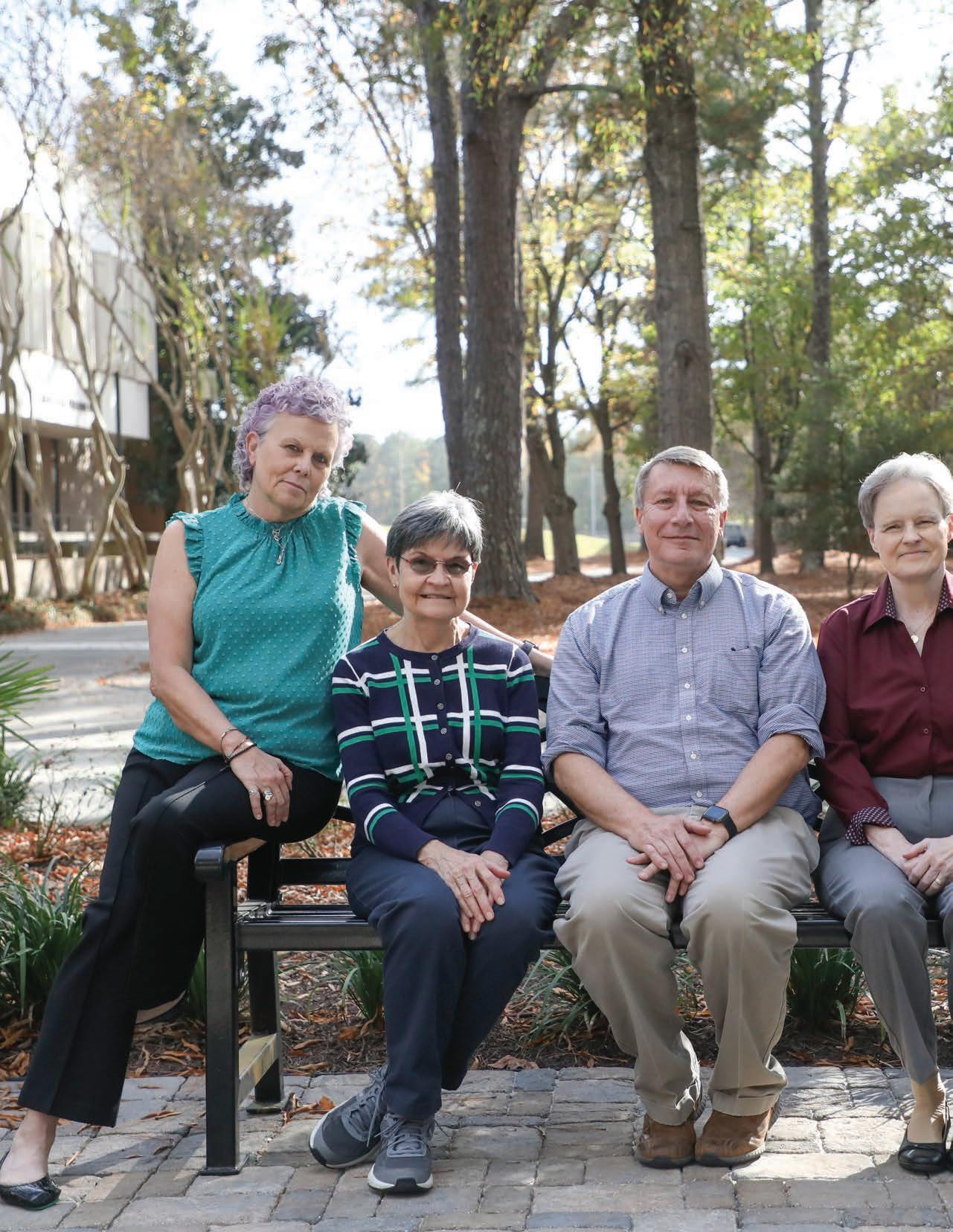

Shared governance is the oil that lubricates the operation of a university. Behind the scenes, in the recesses of the great academic machine, it quietly does its job, making everything run smoothly.
Out of sight, and out of most people’s minds, it is seldom noticed — unless it’s gone.
Long-time denizens of Francis Marion University know this all too well. Three decades ago, FMU had no working arrangement for the shared responsibilities between faculty and administration. The resulting chaos demoralized faculty and put the institution in dire straits. Enrollment faltered. Decision-making went off the rails. The university found itself on the American Association of University Professors’ censure list.
“It was a bleak time around here,” says Dr. Charlene Wages, a long-time FMU faculty member who is now the university’s vice president for administration. “It wasn’t clear what the future held.”
A new president, the current one, Dr. Fred Carter, arrived in 1999. Among his first acts was to encourage the faculty to develop a new constitution, built on the principle of governance shared between the faculty
Many of FMU’s past faculty chairs are still active members of the university’s faculty and administration. They include (from left): Dr. Beckie Flannagan (Faculty Chair (2012 – 2017), Dr. Charlene Wages (2000 – 2004), Keith Best (2008 – 2012), Dr. Sharon O’Kelley (2022 –present), Glen Gourley (2017 – 2022)
Not Pictured: Dr. Ken Autrey (2004 – 2008)
and the administration. Living by that framework has been one of the hallmarks of this administration’s tenure at FMU, and it has shaped the university’s strong growth over the past decades.
FMU will celebrate — quietly, of course— 25 years under the new constitution next year. It’s a landmark by any measure, says Carter.
“Anybody who really understands how a university works understands the value of the principle of shared governance,” says Carter. “Universities that have a strong tradition in that area just work better. Decisions are better. Programs are better. The quality of your people is better, because good people want to work at a place that embraces those values. That was obvious 25 years ago and it’s still obvious today.”
Shared governance refers to the process and policies created to ensure that every segment of the university community — faculty, students, governing boards, administrators — have input in the decision-making and strategic governance of the university. That includes carefully defining roles and responsibilities.
Welcoming faculty into the process is a critical part of that. During the past 25 years, the university has enjoyed stable and consistent faculty leadership. Carter, a political scientist with a significant pedigree as an academician and faculty leader himself, has enhanced that profile by regularly bringing talented faculty into formal administrative roles at the university. Dr. Charlene Wages, the long-time VP of administration, is just one of many examples.
FMU’s faculty governing body is organized into two committees, the Academic Affairs Committee and the Graduate Council. Representatives from these two councils bring issues and proposals to the Faculty Senate, which is headed by the chair of the faculty. The chair of the faculty represents all faculty before the administration and is a member of Carter’s senior staff.
The chair’s foremost role is advocating for the faculty, as a whole, with the administration, says Dr. Rebecca Flannagan, the chair from 2013-17. But the duties of the office extend well beyond that. Flannagan says that as chair she was very much a part of FMU’s senior staff and was expected to weigh in on issues before
the group whether they directly affected academic operations or not. Additionally, she served as a crucial conduit of information from the administration to individual faculty members.
The faculty chair also presides over an active and robust faculty governing apparatus. Besides the Academic Affairs Committee and the Graduate Council, the faculty also maintains 16 standing committees that advise on issues under each group’s purview.
There have been seven faculty chairs in FMU history, and six since Carter assumed leadership of FMU. As the math suggests, most have held their post for fourto-five years, giving them time to learn the job and improving their effectiveness.
Five of the six chairs to serve with Carter are still at FMU, including Dr. Sharon O’Kelley, who moved into the role this year. That experience has added to the strong foundation for shared governance at the university.
Dr. Wages, namesake of FMU’s prestigious faculty award for contributions to shared governance, says a sound governance system is critical to a functional university. Wages would know. She served as chair of the faculty senate prior to Carter’s arrival and as chair of faculty from 2000-04. Wages champions the importance of each committee within the faculty governance system.
“I have had two different experiences in shared governance at FMU; first as Faculty Senate Chair and later as Chair of the Faculty,” Wages said. “Based on a comparison and contrast of those experiences, I learned that cooperation and good will within the faculty and between the faculty and the administration are critical to successful shared governance. Without collegiality and respect for the duties of each group, it is difficult to address issues where legitimate differences of opinion may exist.”
FMU’s more recent tradition of collaboration between faculty and administration has produced numerous benefits, say Carter, Wages, and others. It has improved recruitment and retention of faculty, brought more voices into the conversation, and just generally enhanced collegiality on campus. The sharp divide
between administration and faculty, a characteristic of so many universities, is far more muted at FMU. Indeed, faculty who become deeply involved in the shared governance process at FMU often describe it with great fondness.
Professor Keith Best, faculty chair from 2009-13, says he’s had “few experiences in my life equal to my service as the chair of faculty (at FMU).”
“I felt great honor in working with our faculty and administration,” says Best. “And, I am proud of the growth and accomplishments of the university during that time.”
Professor Glen Gourley, faculty chair from 20172022, agrees that ongoing growth and progress is a satisfying byproduct of sound governance, but he also cites the university’s ability to navigate the recent pandemic as an example of how well the system works.
“Through our committee system, the faculty are involved with virtually every decision made by the administration at any time,” says Gourley. “But this became even more evident to me during the recent pandemic. As chair of the faculty during this time, I had the privilege of being a member of the university’s Covid Response Committee. Every decision made during the crisis was guided by the question: ‘How will this impact the wellbeing of the university’s faculty, staff and students?’”
There has been tangible recognition for FMU’s shared governance system as well. FMU’s now annual placement at the top of Modern Think’s Great Colleges to Work For® ranking, is due in large part to the fruits of shared governance. The American Association of University Professors honored Carter with its Ralph S. Brown award, recognizing contributions to the promotion of shared governance in 2002.
On campus, the Dr. Charlene Wages Shared Governance Award, established in 2002, recognizes faculty members who make notable contributions to the shared governance process.
Dr. O’Kelley, a past winner of the Wages award, says her main goal as faculty chair is to do all she can to maintain the tradition of sound and inclusive governance at the university.
“We are known for the shared governance system we have at Francis Marion,” O’Kelley says. “The faculty, staff, and administration work very well together to keep the university moving forward. My primary goal is to keep that momentum going in the form of open communication and transparency. We have a dedicated faculty and staff who are very passionate about their subjects and finding the best ways to deliver the material to students. And then we have an administration that is very supportive. It’s a good combination.” ·
A new faculty award, recognizing achievements and contributions to shared government at Francis Marion, was established in 1999. It is named for Dr. Charlene Wages. Past winners include:
1999-2000 E. Lorraine de Montluzin
2000-2001 Charlene Wages
2001-2002 John G. Rae
2002-2003 Pamela A. Rooks
2003-2004 Duane P. Myers
2004-2005 D. Keith Best
2005-2006 Lucy C. Thrower
2006-2007 Kenneth M. Autrey
2007-2008 Rebecca H. Flannagan
2008-2009 Lynn Hanson
2009-2010 A. Glen Gourley Jr. 2010-2011 Christopher D. Johnson
2011-2012 John R. Hester
2012-2013 T. Alissa Warters
2013-2014 Meredith Love-Steinmetz
2014-2015 Jo Angela Edwins
2015-2016 Travis W. Knowles
2016-2017 James T. Ramey, Jr.
2017-2018 Russell E. Ward
2018-2019 Shawn Smolen-Morten
2019-2020 Karen M. Fries
2020-2021 Sharon K. O’Kelley
2021-2022 Steven Sims

FMU’S FIRST YEAR AS A MEMBER OF CONFERENCE CAROLINAS COULDN’T HAVE BEEN BETTER. THE PATRIOTS WERE COMPETITIVE, SAVED TRAVEL TIME, AND ENJOYED NEW-FOUND COLLEGIALITY.
When Francis Marion’s leaders decided to move the university’s athletic teams to a new conference last year, everyone believed it was a good idea.
One year later, consider those beliefs confirmed.
FMU’s first season as a member of Conference
Carolinas exceeded expectations. A reduced travel load meant fewer missed classes for Patriot student athletes, and it saved a few bucks, too. FMU’s new colleagues proved to be a welcoming and collegial group. And the Patriots found the competition challenging but hardly overwhelming.
FMU won two conference titles in its first year of Conference Carolinas play (women’s volleyball, men’s soccer) and narrowly missed three others (women’s basketball, softball, women’s tennis).
“It was a very good year for us,” says Murray Hartzler, FMU’s director of athletics. “Other than winning a
few more here and there, it’s really hard to see how it could have gone much better. Conference Carolinas is a great fit for us. We’re looking forward to a long and fruitful future here.”
University officials began pondering a move several years ago. FMU enjoyed many fine seasons, and plenty of success, as a member of the Peach Belt Conference, a league it helped found more than 30 years ago. But, as is the case in so much of intercollegiate athletics, the Peach Belt changed over time.
When the league was founded in 1990, its members were split geographically between Georgia and South Carolina. Over time, however, the league became more and more Georgia-centric, as more members came from that state’s centrally administered state college system. Additionally, some members grew into massive schools whose mission and values diverged from those shared by the PBC’s original core.
FMU President Dr. Fred Carter, says exploring new affiliation just made sense.
“The world changes over time,” says Carter. “FMU has matured as a university. A conference that fit at
“THE WORLD CHANGES OVER TIME, FMU HAS MATURED AS A UNIVERSITY. A CONFERENCE THAT FIT AT ONE STAGE IN OUR HISTORY ISN’T NECESSARILY GOING TO FIT AT ANOTHER. WE HAD MANY GOOD YEARS IN THE PEACH BELT, BUT AS WE LOOKED AROUND WE SAW SOME ATTRACTIVE OPTIONS IN CONFERENCES COMPRISED OF SCHOOLS WITH MORE APPEALING VALUES AND ATTRIBUTES. IT JUST MADE SENSE.”
one stage in our history isn’t necessarily going to fit at another. We had many good years in the Peach Belt, but as we looked around we saw some attractive options in conferences comprised of schools with more appealing values and attributes. It just made sense.”
FMU found a willing and useful partner early on in its search in fellow Peach Belt member UNC Pembroke. UNCP is less than an hour’s drive from FMU. The two schools enjoyed a nice athletic rivalry both before, and during the time, they were both Peach Belt members. ▶
One of the biggest benefits FMU has realized in moving to Conference Carolinas is a sharp reduction in travel time. That translates into less class time missed by the university’s student athletes, and just less wear and tear overall. These travel numbers from year one tell the tale:
53 miles avg. road trip distance decrease compared to last year
Number of road trips requiring overnight stays in previous conference 7
No. of road trips in FMU’s previous conference that took more than six hours.
No. of FMU road trips in Conference Carolinas that take more than six hours. ZERO
2 no. of trips requiring overnight stays now
Like FMU, UNC Pembroke was feeling a little disenfranchised by the Peach Belt’s westward focus. Joining forces with FMU made sense. The two schools could share information on their exploration and the pairing offered interested the conference as an enticing possibility.
The strong, existing relationship between FMU President Dr. Fred Carter and Pembroke Chancellor Dr. Robin Gary Cummings also helped push the partnership forward.
Several conferences that met the general criteria were considered, but the exploration quickly focused on Conference Carolinas, a venerable organization that can trace its roots back more than 90 years. Conference Carolinas’ leaders were on board from the start. They were looking to expand and FMU and UNCP were good fits both academically and geographically.
Pembroke and FMU immediately became the largest schools in Conference Carolinas, but are generally in the same ballpark as their new peers. Conference Carolinas schools share similar visions and missions, too. Almost all the schools offer educational opportunities to communities very much in need of same, and they focus on offering the personal touch. Classes are small, relationships are close.
“It’s more of a feeling than anything,” says Carter. “The schools in this conference feel like us. It’s very welcoming.”
Natural affinities meant that discussions moved quickly. The news was announced in the spring of 2020, in the midst of the COVID pandemic. FMU began making plans for its first season in its new conference in 2021-2022.
The most obvious and tangible reason for moving to a new conference involved geography and simple mathematics.
Because the Peach Belt was moving westward, FMU road trips were becoming longer and more taxing for its athletes. Conference Carolinas’ schools are located primarily in North Carolina and South Carolina. It was clear FMU would save time and money playing in the new league.
Hartzler says that those economics played out as expected. Travel in general was reduced — the average road trip dropped by more than 50 miles per trip — and overnight trips fell even more dramatically.
Every FMU athletic team faced seven all-butguaranteed overnight trips while playing in the Peach Belt. In its first year in Conference Carolinas, FMU teams needed just two overnight trips to visit every team in the conference, although a few more were occasionally needed depending upon sport, game time and the like.
“It’s been a big boost for our kids,” says Hartzler. “We’ve always taken our athletes’ academics very seriously. Not missing class, and being fresher for all your classes, make a big difference.”
FMU’s first season of competition in Conference Carolinas was successful. The Patriots won two championships, just missed on a few more, and were competitive across the board. FMU’s leadership didn’t expect anything different, but Hartzler did find one ember in the league’s overall competitive fire interesting.
“Maybe it’s just one season, but it appeared to me, and some of our coaches, that a number of teams (in Conference Carolinas), and in particular teams that had been near the bottom of the standings in certain sports, really picked up the pace last year,” says Hartzler. “I don’t know this, but I think we had something to do with that. We played a lot of these schools before in non-conference games. Pembroke did, too. I think they knew the kinds of teams we would bring.”
More adjustment and future changes in competitive balance are likely. But Hartzler thinks FMU is wellpositioned to handle anything the new conference can throw at it.
He’s hopeful that another pleasing aspect of the new league doesn’t change: the collegial relations between members.
“If I had to say anything surprised me that would be it,” says Hartzler. “They’ve been very professional and very welcoming ever since we began discussions. And that really hasn’t changed since we started playing games. It’s really a welcome change.” ·
FMU’s men’s soccer team completed an unbeaten regular season in Conference Carolinas league play, before dropping a 2-1 heartbreaker to Chowan in the tournament finals. FMU finished the year 12-5-2.

FMU’s women’s volleyball team captured the Conference Carolinas league title, defeating North Greenville in a five-set final. The Patriots finished first in the East Division during the regular season. FMU earned a bid to the NCAA Division II tournament.
FMU’s first season in Conference Carolinas included plenty of highlights. Here’s a look:
FMU’s softball team rolled to the tournament finals before dropping a 1-0 decision to King College. FMU (33-22) earned a berth in the NCAA Division II tournament.
The women’s tennis team finished second in regular season play. They dropped a 4-3 decision to Erskine in the conference semifinals.
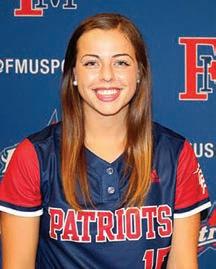
Ashtyn Patterson
Ashtyn Patterson, a senior softball player, was a finalist for Conference Carolinas’ prestigious Murphy Osborne Award, which recognizes outstanding senior athletes who excel both on the field and in the classroom.
The 18-13 Patriot women’s basketball team made an impressive run in the Conference Carolinas Tournament, winning four games before falling in the championship contest.

The lineup of academic majors at Francis Marion is growing so fast the university is having to move the next ones outdoors.
Which is right where they belong.
FMU’s newest academic additions are in the environmental sciences. The university began degree programs this fall in Environmental Science (Bachelor of Science) and Environmental Studies (Bachelor of Arts). A major in Forestry, and advanced degree offerings in Environmental Science are expected to follow shortly.
The new programs address community and national needs. As the world becomes “greener” and more and more attention is focused on issues of the environment and sustainability, there will be more and more jobs for specialists in the environment. And, there’s logic to FMU, a school that has long been known for the natural beauty of its setting, serving as a hub for education in that field.
“Establishing majors in Environmental Studies and Environmental Science makes sense for the university
at this time and place,” says FMU President Dr. Fred Carter. “We’ve always had a setting that was conducive to these studies, and for years, biologists and their students have taken advantage of that. Now, we’re adding top-notch research and laboratory facilities to that mix. Combine that with the growing interest, and need, in this field, and this becomes a very compelling idea.”
The new programs came together quickly, but planning and preparation has been underway for a number of years, driven in part by the continuing excellence of FMU’s department of biology. A large and broadly trained faculty facilitated the exploration of new academic paths. That included planning and building new facilities (see story, page 4).
FMU’s new ecology laboratory, on a pristine lake next to the Pee Dee River, opened last summer, just in time for the opening round of classes in the new majors. Construction is expected to begin on a new Forestry and Environmental Science classroom building in 2024.
The new program also connects with a long-standing partnership between FMU and the South Carolina
Department of Natural Resources (SCDNR). FMU regularly places students with DNR for internships and other extended learning opportunities and partners with the agency in other ways as well. SCDNR already has a branch office on the FMU campus.
A dozen students are involved with the new environmental studies area this year. About half are freshmen, just entering the university.
Dr. Jason Doll, assistant professor of fisheries at FMU and director of the environmental science program, says the program is clearly generating interest and excitement amongst prospective students.
“We’ve had conversations with a number of our existing students (in biology), and our department chair (Dr. Vernon Bauer) said that at our recent open house events, this is the program that a lot of prospective students wanted to talk about,” says Doll. “That’s a trend nationally as well. This is a rapidly developing field.”
Doll thinks the program will quickly double in size and then continue to grow from there.
to the other during their career,” says Doll, “and you’d expect there would be some of that. As they move through the courses, students will begin to understand where their interests really lie.”
The Environmental Science major is, as its name implies, more focused on the science behind the study of the environment. Students will receive a firm grounding in biology and chemistry, while also studying issues related to the environment overall. Majors would be suited for careers involving scientific collection and study of data pertaining to the environment. Likely employers would include government agencies, and private firms that provide environmental consulting to big business.
“ESTABLISHING MAJORS IN ENVIRONMENTAL STUDIES AND ENVIRONMENTAL SCIENCE MAKES SENSE FOR THE UNIVERSITY AT THIS TIME AND PLACE. WE’VE ALWAYS HAD A SETTING THAT WAS CONDUCIVE TO THESE STUDIES, AND FOR YEARS, BIOLOGISTS AND THEIR STUDENTS HAVE TAKEN ADVANTAGE OF THAT. NOW, WE’RE ADDING TOP-NOTCH RESEARCH AND LABORATORY FACILITIES TO THAT MIX. COMBINE THAT WITH THE GROWING INTEREST, AND NEED, IN THIS FIELD, AND THIS BECOMES A VERY COMPELLING IDEA.”
DR. FRED CARTER, PRESIDENT OF FMUFMU’s two-track approach is somewhat unusual. Most universities offer either Environmental Science or Environmental Studies. FMU leaders thought the dual approach would better serve students as they began their academic careers.
“A student who starts in one could easily move
Environmental Studies focuses more on policy and theory surrounding environmental issues. Students would study the science of the environment, but would also study issues in politics, geography, economics, and sociology. “Environmental Studies majors would be aligned with careers in government agencies, politics or private businesses that consult on environmental issues,” Doll says.
Both majors include a large number of multi-disciplinary classes, but there is a particularly strong focus in Environmental Studies. Students in both majors would benefit from the knowledge and teaching of FMU’s English, Sociology, Political Science, and History Departments, and from the School of Business. That’s in addition to connecting with the university’s biologists and chemists.
The first majors are expected to graduate in 2027.
ENVIRONMENTAL OUTLOOK (U.S. BUREAU OF LABOR STATISTICS, 2021) The future for students in FMU’s new Environmental Science Program is bright.
NPLI IS BACK IN ACTION AFTER COVID BREAK. TWENTY-ONE-YEAR-OLD INITIATIVE SUPPORTS NON-PROFITS ACROSS SOUTH CAROLINA.
BY ANNA KATHRYN STROM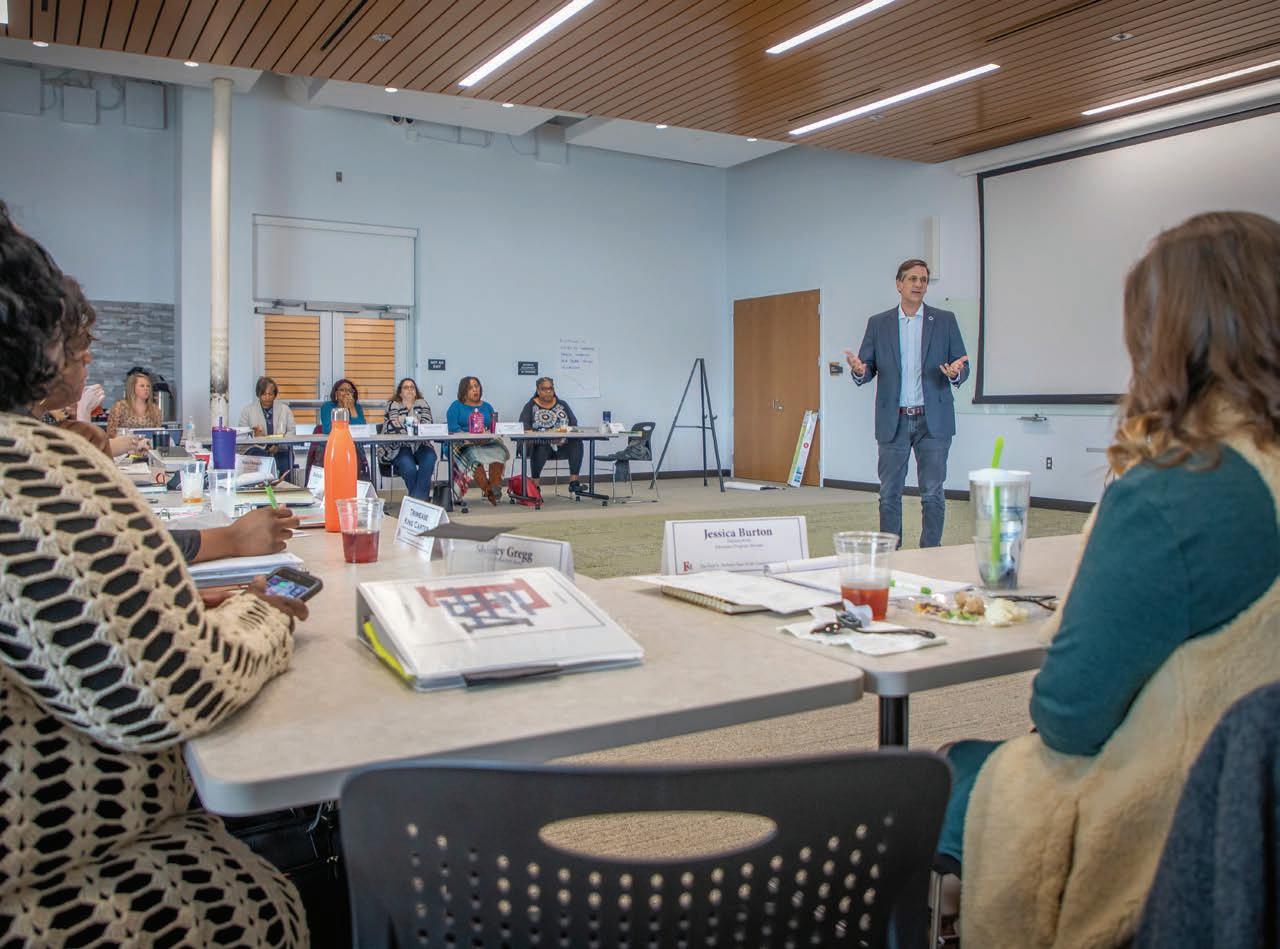
After a short break, NPLI is back.
Non-profits in the Pee Dee and across South Carolina couldn’t be happier.
NPLI — formally, the Fred R. Sheheen Non-Profit Leadership Institute — is a 21-year-old initiative created by its namesake in conjunction with his longtime friend and associate, FMU President Dr. Fred Carter. NPLI addresses the need for an ongoing leadership education program for non-profit leaders in the region. Carter and Sheheen knew that non-profits played important roles in improving lives and enhancing communities. They also knew that many needed help organizing and growing their organizations.
Carter renamed the program — originally, it was just the Non-Profit Leadership Institute — in Sheheen’s honor in 2017 after his passing. Aside from leading
NPLI, Sheheen enjoyed a sterling career in journalism and governmental leadership.
“The program allows the university to provide valuable resources to the South Carolina non-profit community,” says Lauren Stanton, Vice President of Institutional Advancement, which helps manage the program. “This Institute provides participants with the opportunity to learn from a diverse panel of subject matter experts and to engage with their peers from around the state. It is an honor to support their missions and help further their success.”
“Non-profit leaders are vital because they do such noble work in our community by helping to improve the quality of life for so many,” says Chuck MacNeil, who succeeds Sheheen as Director of NPLI. “NPLI provides them with an opportunity to learn skills and techniques to improve effectiveness and efficiency.”
Since its founding, NPLI has helped more than 400 non-profit leaders from over 200 organizations sharpen their skills and build support networks. The program brings the leaders in each NPLI class together for 11 sessions across seven months on a variety of subjects. Topics covered include human resource development, financial resource development and management, public policy and more. Each session is led by a recognized expert in their respective field, including non-profit leaders, seasoned university faculty members, public officials and even NPLI graduates. The interactive sessions include discussion and case studies.
Through the course, participants can explore cutting edge and time-tested strategies that can enhance numerous aspects of their organizations. Non-profit leaders also have the chance to form strong professional relationships with others from organizations across South Carolina in a cohort setting.

NPLI classes are one of FMU’s best-known community outreach programs. Classes are almost always full, and as word has spread, non-profit leaders have come from farther and farther away to participate.
That momentum was interrupted two years ago when classes were suspended at the onset of the COVID-19 pandemic. Classes resumed this fall. Pent up interest quickly filled the class with 30 participants. A waiting list for future classes also had to be created.
NPLI classes are held at The Continuum in Lake City, a regional center for education and workforce development.
Upon successful completion of the program, participants are awarded the NPLI Certificate and earn three hours of college credit for a Non-Profit Management class at Francis Marion University.
Fred R. Sheheen, a Camden, SC native whose career was spent in public service to the people of South Carolina, was the longtime director of the NPLI, and poured his heart and soul into the unique organization, which offered affordable education and mentorship to leaders of non-profit organizations across the state. Sheheen was killed in a tragic auto accident in fall 2016.
In addition to naming NPLI in his honor, FMU also established a university scholarship in Sheheen’s name. Furthermore, an annual non-profit service award, bestowed annually by the South Carolina Association of Non-Profit Organizations (SCANPO), was named for Sheheen.
Remembered as a champion of higher education, he served as the head of the South Carolina
Commission on Higher Education, which oversees public colleges and universities, for 10 years. Sheheen graduated from Duke University in the late 1950s and began his career as a journalist at The Charlotte Observer, focusing on civil rights issues.
Sheheen later worked as an aide for S.C. Gov. Donald Russell before moving into the world of South Carolina higher education. He served as the director of the South Carolina Commission on Higher Education from 1987-1997.
After leaving the CHE, Sheheen moved into his role as director of the fledgling NPLI, as well as continuing to work with a variety of non-profit and public boards and organizations in the state.
THE SOUTH CAROLINA GOVERNOR’S SCHOOL FOR SCIENCE AND MATHEMATICS JOINS
THE GROWING GROUP OF INSTITUTIONS TAKING ADVANTAGE OF FMU’S DUAL ENROLLMENT PROGRAM
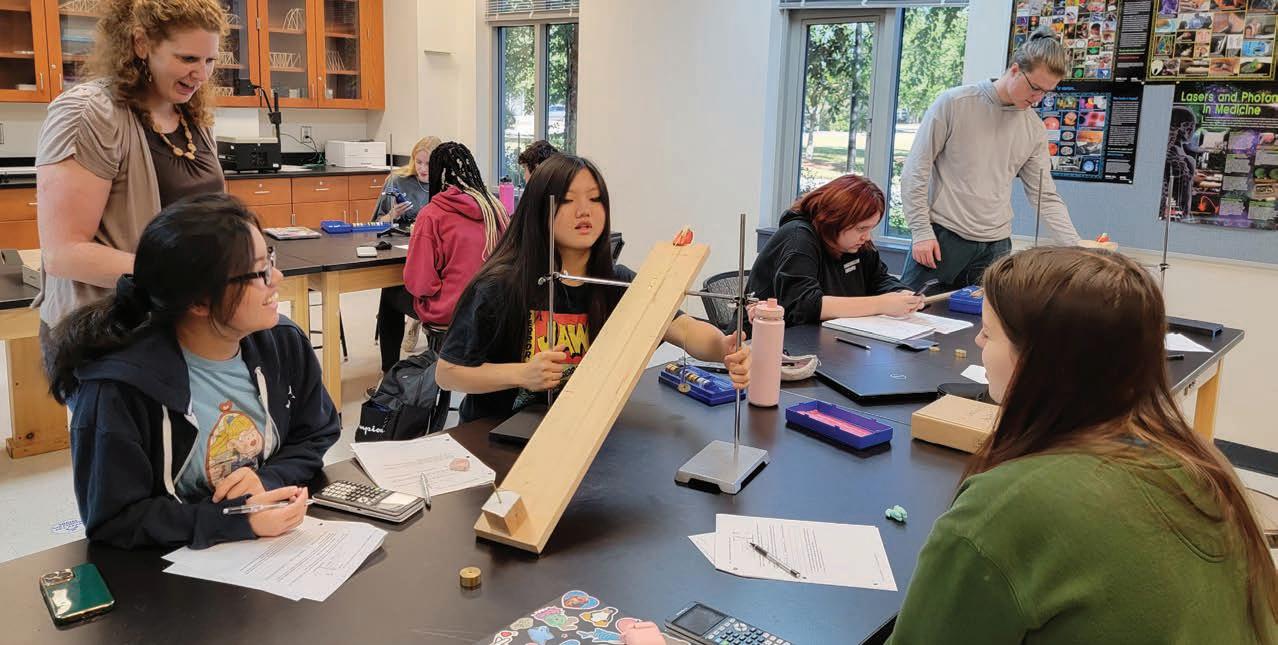
its fast-growing dual enrollment classes.
The South Carolina Governor’s School for Science & Mathematics (GSSM) in Hartsville is now on board. Beginning this fall, students at the GSSM are earning college credit for courses in Physics, Chemistry, Economics, and English. GSSM is the 14th dual enrollment partner to engage with FMU since the university re-launched the program in 2019.
The centerpiece of the dual enrollment program is The Continuum in Lake City, a multi-faceted educational center where students from a number of local schools and school districts take dual enrollment classes. While students come to The Continuum for classes, others receive instruction at their schools. That’s the case with GSSM.
Dr. Michael Newsome, Vice President of GSSM, says the dual enrollment program enhances the school’s existing curriculum. GSSM is a two-year residential program where students spend their last two years of high school immersed in a specialized, college-like environment. Prospective students must submit an application and be interviewed for admission after their sophomore year of high school.
“This partnership allows us to expand our upper-level offerings in a way that some of these great students will be able to show the colleges they apply to that they are capable of advanced work,” says Newsome.
Says FMU President Dr. Fred Carter, “President (Daniel) Dorsel and his faculty are doing wonderful things at the
Francis Marion University is pleased to enter into this meaningful partnership with them.”
“The strength of Francis Marion’s curricular offerings in the sciences, mathematics, and humanities makes this a natural alliance (with GSSM and other schools),” says Carter. “It allows us to work collaboratively and creatively in educating some of the finest students in the state.”
The GSSM partnership is the latest success in FMU’s booming dual enrollment program. Nearly 500 students – the most ever in the program’s history – are enrolled in the dual enrollment program this fall. They come from a variety of Pee Dee high schools and institutions.
Professors for each class are members of the FMU faculty. Some are teachers at the feeding school who are specially certified by FMU for the dual enrollment program. Carter notes that the dual enrollment program works well, and has been so popular, because it builds on FMU’s long-time strength as a teaching institution.
The popularity of the programs is expected to grow even further starting fall 2022, says Anna Todd, Former Director of Dual Enrollment and Continuing Education at Francis Marion.
“The response we saw from our partner school districts, and especially the participating students, has truly been incredible,” Todd says. “There is such high demand for these courses among local high school students. We look forward to the program continuing to grow in the years ahead.”

SPRING DATES:
JANUARY 21
FEBRUARY 4
2023
MARCH 4
APRIL 1
Open House events provide soon-to-be Patriots with a chance to meet with University faculty and staff, as well as members of the student body to learn what their future at FMU will be like.
 Sign up for Open House:
Sign up for Open House:



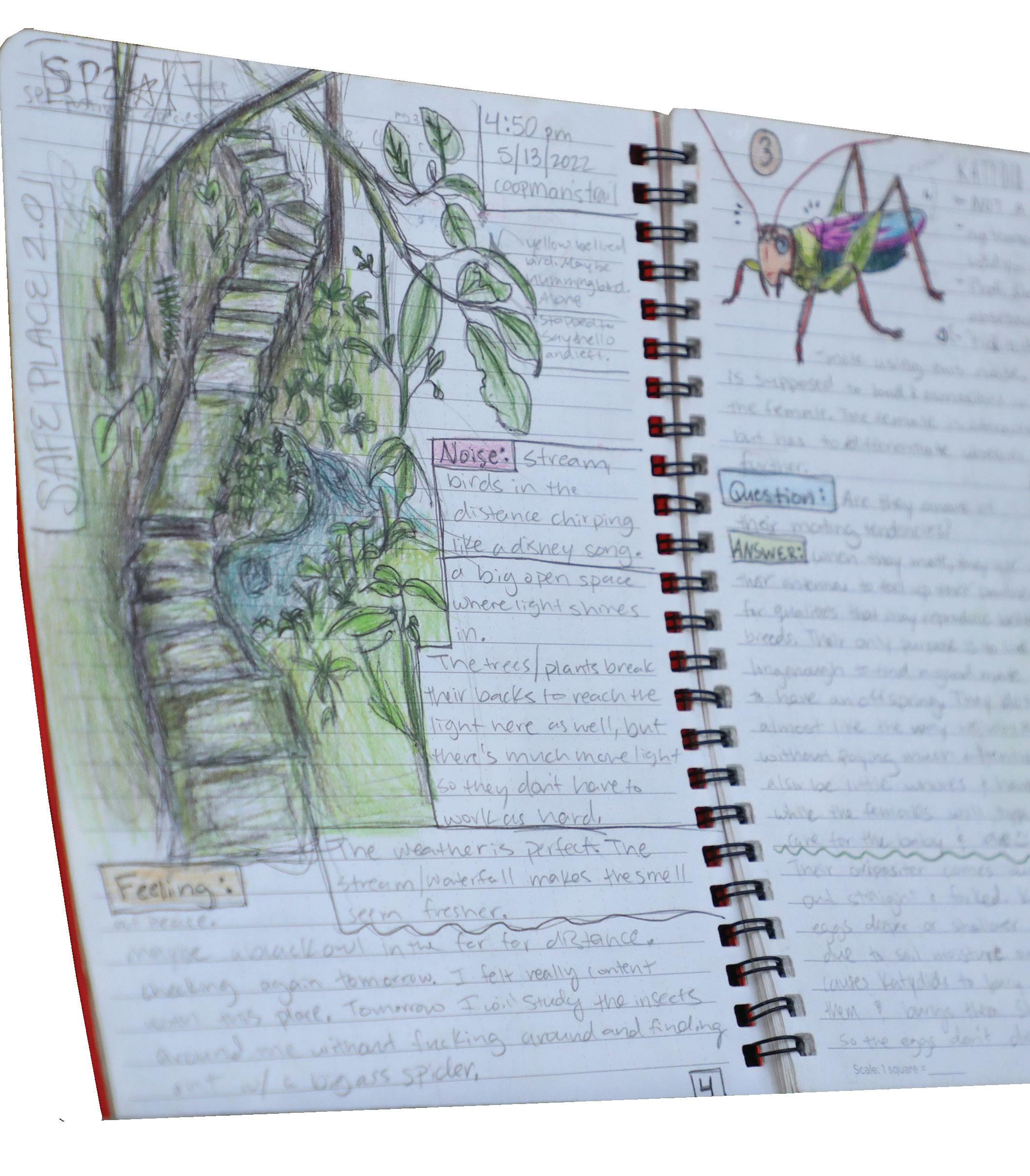 BY ANNA KATHRYN STROM
BY ANNA KATHRYN STROM



For more than a decade, FMU students have experienced the magic of the university’s Wildsumaco Biological Station in the Ecuadorian Andes.
Breathtaking vistas, up-close encounters with exotic wildlife, an interlude away from the ultra-connected life of modern America — it’s all there in the jungle surrounding the Sumaco volcano, and its power cannot help but transform a young life.
Many have come under its influence. Few have described it better than Brittany Sehnke.
You might even say she was drawn to it.
Sehnke, a senior from Florence, traveled to Wildsumaco last May with a small group of students led by FMU biology professor Dr. Nathan Harness. As part of a three-week Biology 102 course, each student was required to keep a journal. Students spent an hour or more each day documenting their experiences and observations.

An art education major, Sehnke added a special touch to her journal: a set of skillfully detailed drawings that described her experiences in a uniquely vivid manner.
Harness calls Sehnke’s drawings “the best illustrated observations and journaling that I’ve seen.”
“She was constantly exploring at every scale,” Harness says. “Walking new trails, turning over rocks in a stream or looking closely at a new patch of grass. She was able to take her sense of awe at the place and turn it into art. Because she’s so good at this, it’s easy to see the huge impact Wildsumaco had on her.”
Art has always been Sehnke’s favorite method of expression.
“I’ve doodled my whole life,” she says.
Her doodling turned into something more serious and complete as she studied art in school.
More recently, it helped her discover a career path.
“When I reached my high school art class, I was inspired by my teacher. I wanted to be like her. So I decided I would go to school for art education. It combines my two favorite things, drawing and teaching. I like using art to teach people and watch them grow.”
Necessity played a part in Sehnke’s turn to a more innovative and artful form of journaling. Cell phones weren’t allowed at Wildsumaco, so the ever-present cell phone camera wasn’t available to her.
For someone with Sehnke’s skill, that wasn’t a big hurdle.
“It was really hard to go without my phone for the first day, but after that, I got used to it and felt like I didn’t need it anymore,” says Sehnke. “The first thing I did was birdwatch. That’s what first got me wanting to draw things.”
Sehnke quickly became eager to learn as much as possible about the ecosystem around her, and with most technology out of reach, she had to be extra resourceful to create some of the artwork in her Wildsumaco journal. For instance, she made leaf prints with ink she made by smashing berries in a rock she hollowed out herself.
Sehnke’s journal depicts an array of experiences. A run-in with a group of wooly monkeys was the inspiration behind one of her most detailed sketches. She also encountered tarantulas, dart frogs, and hummingbirds (a Wildsumaco specialty) who slurped sugar water out of the students’ own hands.
Experiences like that cannot help but affect young lives. They make impressions that last a lifetime.
“The trip changed all of us,” Sehnke says. “I think that was the happiest I’ve ever been in my entire life. I enjoyed meeting new people, being present with the people I was with, and learning a new culture. I definitely want to keep doing those things.”
“I think everybody should do something like this at least once in their life,” she says. “It’s just eye opening. You learn a lot about yourself. I wish I could still be

Brittany Sehnke, left, with her journal. Bottom, Sehnke and friends at Wildsumaco. Above and right, pages from Sehnke’s journal.
there. If it were up to me, I wouldn’t have come back.”
Harness says that while Sehnke was able to express the emotions surrounding her journey in a particularly interesting way, her experience was not unique.
“Most of our students come back from Wildsumaco having had a transformative experience,” says Harness. “That’s the big reason we have a field station there, and why we spend so much effort bringing students.”
“The field station is an amazing place to learn about ecology, but it is more than that,” Harness says.



“Being in a place like Wildsumaco changes your worldview. Students come back with a different understanding of nature and culture and how they fit into the world. They’ve got new passions and a different sense of what is possible for them.”
Every student in Sehnke’s group was an education major. Usually a trip for upper-level biology majors, Harness chose to extend this opportunity for the first time to his Intro to Biology for Education Majors class – a course he teaches yearly. The objective of this particular class is to instill the importance of science in future teachers, and give them the tools they need to help their students engage with nature.
“There is really no more powerful way to make impassioned educators than to show them the magic of science in a place like Wildsumaco,” Harness said.

“That builds more effective teachers for an entire career’s worth of their future students.”
Due to the success of this group of students, Harness plans to return to Ecuador with another group of education majors for the next trip in summer 2023.
The connection between students in the same major likely added to the bonds the group formed. Group members are now busy looking for ways to keep their “Wildsumaco high” going.
“We’re all still in touch,” says Sehnke. “We’re starting a nature club on campus to introduce other students to nature journaling. The club gives us a reason to go on hikes, look at bugs, and do the same things we did together in Ecuador. Even though it’s not the same as being in Ecuador, we want to try to bring that experience here.” ·
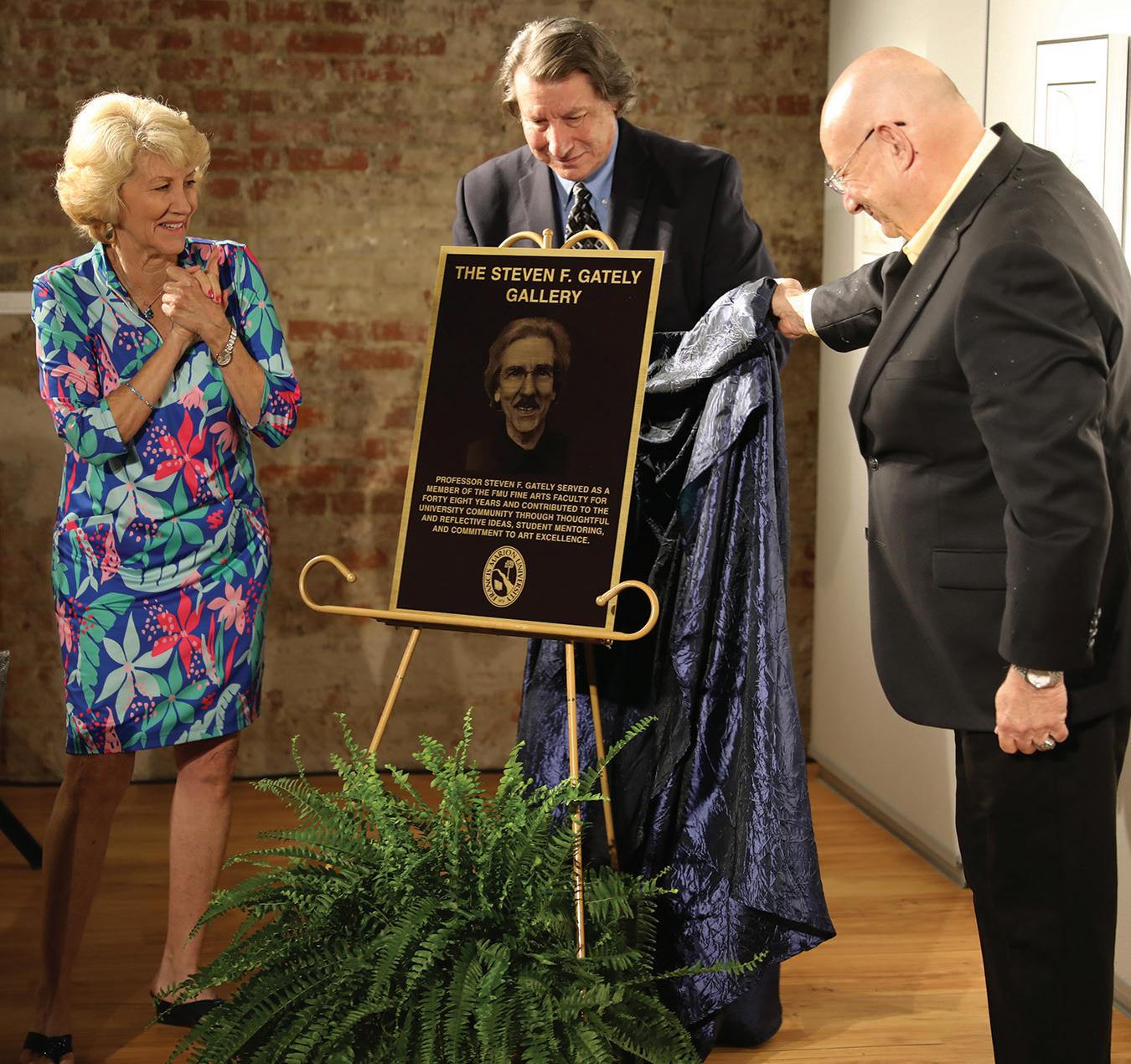
The downtown art gallery at University Place is renamed the Gately Art Gallery, in honor of the late Steven F. Gately, a talented artist and long-time professor in FMU’s Department of Fine Arts.
FMU’s trustees and administration freeze tuition for the fourth straight year.
A rare snowfall blankets the Pee Dee, FMU included.

Francis Marion University is admitted to the South Carolina Sea Grant Consortium, a group of nine state universities involved in serious research aimed at improving the lives of South Carolinians in the Coastal Region.
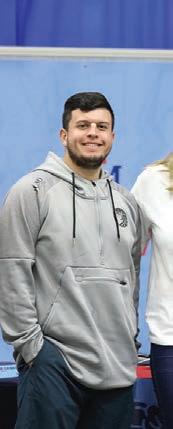

RECENT EVENTS ACROSS CAMPUS COMMUNITY.
FMU honors five esteemed grads at its annual alumni awards ceremony. Winners included Robert E. Lee (’87), Outstanding Alumnus of the Year; Tyler B. Wright (’19), Benjamin J. Wall Ingram III Young Alumni of the Year; Stephen N. Jones (’88), Professional Industry Award for Business and Industry; Charnisse T. Kelly (’96), Professional Industry Award for Medical and Health Sciences; and Jenna Lee Sexton (’07), Professional Industry Award for Natural and Behavioral Sciences.
Dr. Lynn Hanson, retired FMU English professor, delivers the annual Moran Address. Her speech was entitled “Learning By Doing: From Pretending to Becoming.”
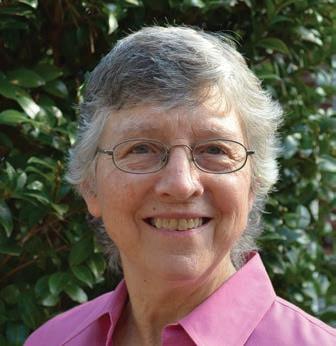

FMU is recognized as a Military Friendly School.


LIFO the Party, a team representing the Accounting and Finance Club (AFC), wins the fifth annual FMU President’s Bowl quiz competition. LIFO defeated the Pi-Rates, a Math Club entry, in the championship match. Winning team members are Taylor Gribben, James Gaskins, and Brandon Cook.

A new scholarship was created in memory of Frank Elmore (’03), a distinguished FMU alum and longtime member of the board of trustees.

The annual Arts International festival returns
FMU was awarded its third Center of Excellence by the South Carolina Commission on Higher Education. The new Center of Excellence for Teacher Retention and Induction in the Pee Dee (COE-TRIP), will focus on earlycareer teachers’ effectiveness, resilience, and well-being. The center is funded by a $347,000 grant. The center will be housed in the FMU School of Education.

Jahylin Baxter belts out a tune during the annual “FMU’s Got Talent” competition. Jahylin Baxter won the competition.


returns to the FMU campus. to FMU campus.
FMU’s Board of Trustees once again extended the contract of President Fred Carter, this time through 2029. Carter, who arrived at FMU in 1999, is the longest-serving university president in South Carolina.
FMU names five former faculty members professors emeriti. The new emeriti are: Dr. Fred R. David, Dr. David P. Franck, Mr. Jack G. Griffith, Dr. Kevin J. Lasher, and Dr. Ronald T. Murphy.
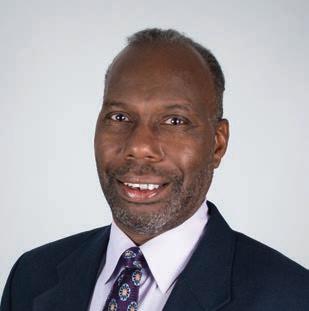
Dr. Leroy “Pete” Peterson, professor of Chemistry, is named the J. Lorin Mason Distinguished Professor for 2022. Peterson (’84) has taught Chemistry classes at FMU for 32 years.
Mr. Steven Sims, Head of Access Services and Associate Professor, is named recipient of the Charlene Wages Shared Governance Award. Dr. Erica Johnson-Edwards, Associate Professor of History, receives the Award for Excellence in Professional Service. Ms. Padmaja Rao, Assistant Professor of Computer Science, receives the Award for Excellence in Teaching. And, Dr. Jeremy D. Rentsch, Associate Professor of Biology, receives the Award for Excellence in Research and Scholarship.

Anthony Melo's expression conveys the electric feel of the spring commencement ceremony. Grads celebrated their accomplishments at the first regularsized events since before the pandemic. Highlights included the first grads in FMU's mechanical engineering program.

Garth Thomson (’91, ’97), the longest-tenured coach in FMU athletic history, retires following 30 seasons at the helm of FMU’s tennis teams. Thomson, a Zimbabwe native who came to FMU on a tennis scholarship, holds the school record for singles victories (63). As coach, Thomson managed a 63 percent winning percentage and took 15 Patriot teams to the NCAA Tournament.
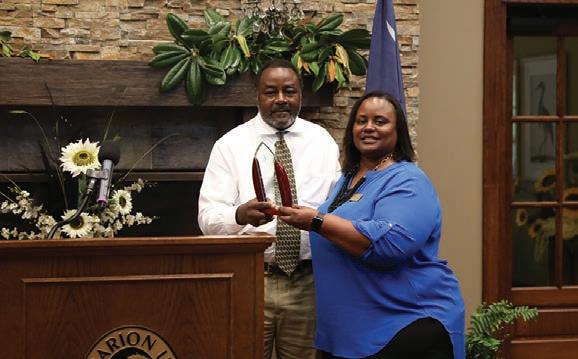
LaTasha Brand (’02), FMU’s Dean of Students, receives the African American Faculty Staff Coalition’s annual Diversity Award at the AAFSC banquet.


FMU becomes the first university in South Carolina to be classified as a Professional Doctorate University. The classification, approved by the South Carolina Commission on Higher Education (CHE), enables Francis Marion to offer additional doctoral programs in the field of health sciences or other professional disciplines. FMU currently offers a Doctorate of Nursing Practice and is expected to add a Doctorate of Occupational Therapy in 2024.


FMU announces that it will name its new ecology center after professor emeritus Dr. John G. Rae III and an academic computing lab after long-time employee Teresa McDuffie, who retired in May.

Professor Glen Gourley received the South Carolina Theatre Association’s Lifetime Service Award during the organization’s gala in Charleston.

FMU honored the best of the best at its annual staff award luncheon. Brigid E. Kennedy received the Marvin Lynch Humanitarian Award, and Dr. Cheri L. Richardson was presented with the John J. Kispert Leadership Award. Erick Polite and Laura Rhoads were named winners of the University’s two Outstanding Staff Service Awards.

More than 700 freshmen and new students arrive on campus at the annual move-in day. Welcome, new Patriots!
Fall Semester begins.

The FMU community celebrates the opening week of school with its annual festival at the Griffin Athletic Complex.

Long-time FMU employee Pat Boswell (’77) retired in August. A supervisor in the facilities area, Pat was a fixture at FMU campus events for almost three decades.




FMU was ranked in a record seven categories in U.S. News & World Report’s annual college rankings.

Country music star Josh Turner, a former FMU student from Hannah, S.C., delighted a hometown audience at the PAC in October.

A Perfect Great College (again). For the 10th straight year, FMU was ranked among the Great Colleges to Work For. For the second year in a row, FMU received the highest possible ranking in every category.

Professor Travis Knowles was appointed as the 2022 Trustees’ Research Scholar.
Fond memories have always been a part of the FMU experience. Here’s some recent thoughts from some of our alumni.
“
(FMU’s first dean of the School of Business)
Dr. Morgan Coker was a big influence on me attending Francis Marion University. He was chairman of the Business Department at the time.
He told me that FMU would be a great place for me to go. His family was from the Turbeville, S.C. area, which was my area of Clarendon County, so that was where I ended up. My wife actually attended FMU as well. She was a year behind me. I was a senior, she was a junior, and we were married while we were in college. What impressed me was the fact that all of the professors were very personal and always had open-door policies. My accounting instructor Carroll Webster and Dr. Coker made a big impact on me during my time at Francis Marion.
FMU is probably the best-kept secret when it comes to choices for a university.
Mr. Alan L. Gibbons (’80)
“FMU prepared me for life experiences. When you go to college, your parents aren't there to push you, so being here prepared me for that. A few professors gave me advice, and I implemented it in my life whether it be work related or life, and I can see how their advice helped me out. When I look back and see how far the campus has grown, and all the changes that have been done to the campus, such as the accomplishments that the school has received, it's an honor to say that FMU is the college I attended.”
Mr. Kwanza Keon Benjamin (’01)
The relationships that were built there make me smile, but the biggest smile is from the quality of education that I received.
Dr. V. Callicutt (’79)
“
It was tough, but that was what made me feel prepared.
Andrew Rewis, Jr. (’18)
“
FMU was home and a safe place. I wouldn't trade it for anything in the world.
Molly
Moonwind, (’95)
“I started out at Francis Marion University with the intention of transferring out, which never happened. I wanted to start small and maybe branch out to a larger school... but once I got there, I actually really, really enjoyed being there on campus and everything. I liked my instructors and the people that I met, so I made it home. The thing that stood out for me in my experience at FMU was that if I had transfered I would've never met my husband my last year there. Interestingly enough, my husband and I had been on the same campus for at least two years before we met, but we never crossed paths until the fall semester of my senior year. He was on his way to his science class in the Leatherman building. I was leaving the business school, heading to the University Center. We crossed each other while walking on the sidewalk in between the buildings. I didn't notice him, but he noticed me. Whenever I got to the University Center, I sat down. He was standing there, and he introduced himself to me. We've been married for 17 years, and we have been together for 23 years.”
Mrs. Stephanie Forte (’99)
“I would tell anyone who wanted to attend FMU to enroll as soon as possible. If I could make the grade, then the young folk right out of high school can make it, too. Being an alumna of FMU really helped me my whole life, and I made so many friends. It's great to be able to say that I attended FMU.”
Mrs. Mary Rainey (’81)
It was a great place to find myself and figure it all out.
Lorene Strange Godbold (’97)
“At the time, it was Francis Marion College, and one of my best friends from high school was attending FMU. He had been there for a year before I started. It seemed like it was a smaller and more comfortable fit for me. That was pretty much why I enjoyed it. My family were all strong Christians, so when I got there to school, I was able to get connected with the fellowship of the Baptist Student Union there. It felt a little bit like home. One of the guys who became one of my best friends is still a lifelong friend even though we are states away. He lives in Texas, but we are basically doing the exact same thing. We are both chaplains for hospice, and his name is Rodney. When we graduated from FMU, we both went on and attended seminary. I got my master's degree, and I went on from there. I went on to Covington Seminary and got my doctorate degree. I taught at the seminary for a while and then started working in the health care system. One of the things that helped motivate me in my career as I was there being a part of the Baptist Student Union was it broadened my horizons as to what I could do. I majored in psychology, and that turned out to be a tremendous resource for me, because I went on to get my master's degree in pastoral counseling. I'm a chaplain and a bereavement counselor with a local hospice in Savannah, Georgia. Having that psychology background has tremendously helped me throughout my life.”
Mr. William Daniel Smith (’91)
“ I was able to help people because of the foundation that was instilled in me.
Jasmine Aquilia Watson (’20) “
The
education I got there has been the foundation of what I would like to think is my success. FMU means the world to me.
Mr. Mark S. Bendenbaugh (’86)
“I went to Francis Marion University on scholarship to play soccer, and I ended up running track and cross country as well. It was fun. I enjoyed it, and I had a great time. Dr. Whiteley, who was the cross-country coach, was awesome. He cared about my athletics, but he cared more about me as a person. He saw potential and asked me to come, and the next thing was I was on scholarship. He involved me in a lot of things, and he was a good guy. The biggest thing was FMU gave me an opportunity in any realm that I wanted. I played three different sports, and if I advanced in the student council side, I was in a national honor society. What I liked about FMU was that it was a small group. I had great professors in the Math Department, Business Department, and in every aspect. The grounds were impeccable, and it was a clean and pretty campus. I was an accounting major in my first three years, and I switched to chemistry and math. I was a double major, so I went on and got a master's in polymer chemistry. FMU prepared me not just for the academic side but also for the things that I did not realize until later in life.”
Mr. Mark H. Wilson (’95)
“ “My career has taken a different path, but my experiences, classwork, and professors definitely helped me frame my mindset so that I could always be a leader in whatever industry I pursued. I walked away from FMU with such an amazing education that I just felt super prepared for the real world and able to make a difference somewhere.
“I had always heard Francis Marion University was a great school to attend. I have family members who are alumni, including my dad. My whole experience at FMU left me feeling changed in a lot of ways. I met some of my best friends at FMU. My favorite professor was Dr. Sarah Kershner, my advisor and the director of the program that I graduated from. She is unparalleled. Francis Marion University definitely prepared me for the real world. My degree helped me land my first job. My education from FMU is helping determine my career path and the focus of my master's as well.”
Ms. Sidney Elizabeth Coker (’19)
